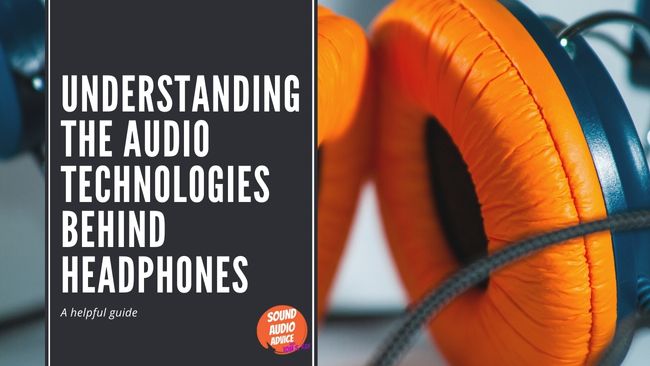
Headphones and Noise-Cancellation: How it Works and Why It Matters
March 16, 2023
Headphones for Different Lifestyles: Gaming, Fitness, Travel, and More
March 16, 2023
Understanding the Audio Technologies Behind Headphones
Greetings, audio aficionados! Ever wondered what lies beneath those trusty cans hugging your ears? Join us as we unravel the mysteries behind headphone technology, delving into the captivating science of sound. Equip yourself with the knowledge to make informed choices and elevate your listening experience to new sonic heights!
The Fundamentals of Sound
Before we dive headfirst into the world of headphone technology, it’s crucial to get a grip on the basics of sound itself – after all, it’s the very foundation of our audio endeavours. Picture it as a thrilling journey through the aural landscape, with your ears as your trusty steed.
Sound, in its essence, is a form of energy produced by vibrating objects. These vibrations create pressure waves that travel through the air (or other mediums, such as water or solid materials) and eventually reach our eardrums. The eardrum, being the sensitive chap that it is, vibrates in response to these pressure waves, converting them into nerve signals that our brains interpret as sound. Quite the journey, wouldn’t you say?
Now, let’s talk about sound waves and frequencies. Sound waves have peaks and valleys – much like the ebb and flow of the ocean, or your emotions during a dramatic film. The distance between two consecutive peaks is known as the wavelength, and the number of peaks that pass a point in one second is the frequency, measured in hertz (Hz). High-frequency sounds have more peaks per second and are, well, higher pitched – think chirping birds or a piccolo. Low-frequency sounds, on the other hand, have fewer peaks per second and are lower pitched, like a rumbling thunderstorm or a bass guitar.
Our ears are remarkably sensitive and can perceive an astonishing range of frequencies, typically from 20 Hz to 20,000 Hz. However, this range can vary from person to person and tends to decrease with age. So, while your teenage years may be filled with the sweet sounds of high-frequency melodies, you might find them slipping away as you grow older – much like your tolerance for loud music and all-nighters.
In summary, understanding the fundamentals of sound – from vibrations and sound waves to frequencies and human hearing – is the foundation upon which we can explore the marvellous world of headphone technology. So, with the basics under our belt, let’s venture forth into the realm of audio wizardry!
Types of Headphone Technologies
As we embark on our quest through the realm of headphone technologies, it’s essential to acquaint ourselves with the various breeds of audio wizards that dwell within our trusty cans. Let’s meet the key players, each with their own unique charm and sonic prowess.
A. Dynamic (moving coil) headphones: The most common and, some might say, the workhorse of the headphone world. These trusty companions rely on a moving coil (hence the name) attached to a diaphragm. When an electric current flows through the coil, it interacts with a magnet, causing the diaphragm to vibrate and produce sound. Known for their durability, versatility, and cost-effectiveness, dynamic headphones are perfect for everyday listeners and audio adventurers alike.
B. Planar magnetic headphones: Stepping up the game, planar magnetic headphones employ a thin, flat diaphragm with a conductive layer that interacts with a series of magnets. This setup allows for more precise control of the diaphragm’s movement, resulting in improved accuracy and a delightful, detailed sound. However, these sophisticated wizards come with a heftier price tag and often require more power to reach their full potential.
C. Electrostatic headphones: The crème de la crème of headphone technology, electrostatic headphones use an ultra-thin, electrically charged diaphragm suspended between two stators. This configuration enables the diaphragm to move with incredible accuracy, delivering an unmatched level of detail and clarity. Alas, with great power comes great responsibility – or, in this case, a substantial investment and the need for dedicated amplification.
D. Balanced armature headphones: Often found lurking within the realms of in-ear monitors, balanced armature headphones utilise a tiny armature inside a coil that vibrates in response to an electrical current. This vibration moves a diaphragm, producing sound. Compact and energy-efficient, balanced armature headphones are favoured by musicians and audiophiles seeking precision and customisation in their listening experience.
There you have it – the four key headphone technologies, each with its own distinct characteristics and prowess. From the humble dynamic headphone to the luxurious electrostatic, there’s a match for every listener and budget. So, whether you’re a casual music lover or a dedicated audiophile, the world of headphone technology awaits your exploration!
Noise-Cancelling Technology
Picture this: you’re on a long flight, crammed into a narrow seat, and all you want is to escape into the soothing embrace of your favourite tunes. Alas, the constant drone of the engines threatens to spoil your auditory retreat. Enter noise-cancelling technology, the valiant knight that saves the day and restores tranquillity to your ears. But how, you ask? Let’s delve into the magic behind this modern marvel.
A. Active noise-cancellation (ANC): ANC headphones are like having your own personal bouncer, keeping out the unwanted sounds that crash your listening party. These clever contraptions use microphones to detect ambient noise, and then, with the help of some nifty electronic wizardry, generate an opposing sound wave to cancel out the unwanted noise. The result? A serene bubble of peace where you and your tunes can frolic undisturbed. Bear in mind, though, ANC is generally more effective at eliminating constant, low-frequency sounds, like engines or air conditioners, rather than erratic, high-frequency ones.
B. Passive noise isolation: While not as sophisticated as its active counterpart, passive noise isolation is still a worthy ally in the battle against unwanted noise. Rather than employing electronic sorcery, passive noise isolation relies on the physical design of the headphones – such as snug-fitting ear cups or in-ear tips – to create a barrier that blocks external sounds. It’s like building a fortress around your ears, keeping the clamour of the world at bay.
In summary, noise-cancelling technology – whether active or passive – can transform your listening experience, shielding you from the cacophony of everyday life and allowing you to savour your music in peace. So, bid farewell to the relentless hum of engines and the chatter of fellow commuters, and embrace the blissful silence that noise-cancelling technology provides!
Audio Enhancement Technologies
As we continue our exhilarating expedition into the depths of headphone technology, let’s turn our attention to the enchanting realm of audio enhancement. These ingenious innovations serve to elevate our listening experience, transforming mere mortals into veritable gods of sound. So, without further ado, let’s explore the magical tools at our disposal.
A. Digital signal processing (DSP): Imagine having a miniature maestro living inside your headphones, tirelessly working to fine-tune your music. That’s DSP for you! This clever technology adjusts various aspects of the audio signal – such as equalisation, compression, and reverb – to enhance sound quality and create a more immersive listening experience. From balancing out your favourite tunes to simulating the acoustics of a live concert, DSP is like having a personal audio genie at your beck and call.
B. Surround sound emulation: Ever wished you could recreate the thrilling sensation of being enveloped by sound in a cinema or concert hall? Well, my friend, surround sound emulation is here to grant your wish. By manipulating audio signals and employing psychoacoustic wizardry, this technology creates the illusion of multi-directional sound, enveloping you in a rich, immersive soundscape. Prepare to be transported to the centre of the action, without ever leaving your comfy armchair!
C. High-resolution audio formats: For the discerning audiophile, high-resolution audio formats are like a sumptuous banquet for the ears. Offering superior sound quality compared to standard formats, high-resolution audio captures more detail and nuance, resulting in a more accurate and enjoyable listening experience. It’s like feasting on a gourmet meal instead of a humble sandwich – once you’ve had a taste, there’s no going back!
In conclusion, audio enhancement technologies are the cherries on top of the headphone cake, elevating our listening experience to previously unimagined heights. So, whether you’re seeking the perfect audio balance, an immersive sound adventure, or the ultimate in sonic clarity, these enchanting innovations have got you covered.
Wireless Connectivity
As we continue our thrilling adventure through the world of headphone technology, it’s time to cut the cords and dive into the liberating realm of wireless connectivity. Imagine a world free from tangled cables and the dreaded pocket spaghetti – welcome to the magical land of Bluetooth and beyond!
A. Bluetooth technology: Ah, Bluetooth – the invisible thread that binds our headphones to our devices, allowing us to wander untethered through the sonic landscape. By harnessing the power of radio waves, Bluetooth headphones connect to your devices without the need for cumbersome cables. This freedom of movement enables you to dance, run, and frolic to your heart’s content – all while enjoying your favourite tunes.
B. Audio codecs and their impact on sound quality: In the wireless world, not all connections are created equal. Audio codecs are the translators that convert your digital music files into a format your headphones can understand. Different codecs offer varying levels of audio quality and compression, which can affect your listening experience. From the standard SBC codec to the more advanced aptX and LDAC options, it’s essential to consider the codec capabilities of your headphones to ensure a top-notch wireless listening experience.
C. Pros and cons of wireless headphones: Like all things in life, wireless connectivity comes with its own set of trade-offs. On the plus side, you’ll enjoy unparalleled freedom of movement and a clutter-free existence. However, wireless headphones may require more frequent charging and could be subject to occasional signal interference. Additionally, some audio purists argue that wireless technology can’t quite match the sound quality of their wired counterparts – although the gap is narrowing.
In summary, wireless connectivity offers a liberating alternative to traditional wired headphones, allowing you to roam free and untangled as you indulge in your favourite tunes. By understanding the nuances of Bluetooth technology and considering the pros and cons, you can make an informed decision about whether to embrace the wireless revolution or stick to the tried-and-true wired route. The choice is yours – happy listening!
And so, our riveting journey through the wondrous world of headphone technology comes to an end. From understanding sound fundamentals to exploring cutting-edge innovations, we’ve delved deep into the magic that makes our audio experiences unforgettable. Armed with this knowledge, you’re now ready to conquer the realm of headphones and elevate your listening adventures to new sonic heights
Thanks for reading.
Tom
I’m Tom S. Ray and I’m head mastering engineer at Audio Unity Group. I also hold a bachelor with honours degree in music from Kingston University in London, I lecture mastering to students in Edinburgh College and to my online students via my Mastering Mastery audio mastering online course.



